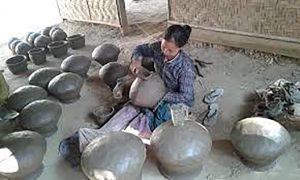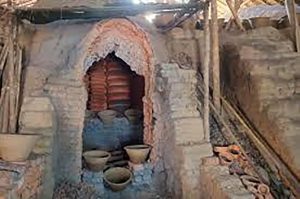June 13, 2020
By Htut Htut (Twantay)
Situated on the outskirts of Yangon Region, Twantay, which can boast of numerous ancient cultural heritages, is a section built in line with archeological characteristics such as ancient pagodas and stupas, city walls, old city, moats and terracotta kilns. The Department of Archeology and National Museum under the Ministry of Religious Affairs and Culture in cooperation with Myanmar Ceramic Society made a joint effort in the preservation of ancient cultural heritages. In 1999, twin ancient terracotta kilns—No 1 and No 2 ancient kilns in the house of U Kyi Than and Daw Nyunt Ye in Kyaukpyarsan, Kankyikon village in Yangon Pada village tract, Tawkyeetan in Twantay—was discovered and another ancient kiln in Phayagyi village. There were a total of three ancient terracotta kilns dating back to about AD 15 and they are now being preserved well.
The Ministry of Religious Affairs and Culture issued an announcement stating that Maungte stupa and its precinct in San village, Twantay Township, southern part of Yangon Region were designated as the ancient building zone with the notification No 4/2008 issued on 4 July in 2008 and Shwesandaw Pagoda in Shwesandaw ward in the same township with the notification No 10/2009 issued on 5 November in 2009. Now Twantay is renowned for its ancient existence alongside scholars, researchers and travel lovers.
Twantay is home to over 200,000 people and comprised of eight wards including 65 village tracts and 235 sub-villages with an area of 365.939 square miles, 27 miles long from east to west and 25 miles long from north to south. Most of Twantay residents have to rely on farming to earn for a living.
For the time being, with the purpose of enabling the historians, terracotta experts and enthusiastic people to make observations about ancient terracotta kilns, the terracotta research museum is open in Nyaungdaga village. The Department of Archeology and National Museum in collaboration with Myanmar Ceramic Society built the terracotta research museum receiving the assistance from Japanese government. Unearthed terracotta pots and broken ones are on display at the museum.
“Most of the terracotta-ware unearthed from the ancient terracotta kilns has a lot of markings, but some don’t have. Pipes (smoking articles) and bowls made of terracotta can be found in the museum. Along Twantay Tawkyeetan was formerly known as the old town of Dala, palace mounds where ancient kings resided, ancient stupas and terracotta kilns can be also spotted. The ancient stupas were built like the ones in Bagan. The historians predicted that unearthed pieces of brick and brick tiles dated back Bagan era. The historians told that further ancient pagodas and stupas, city walls, old city, moats and terracotta kilns would be still in Twantay”, said U Hla Myo, a member of Twantay Township Ancient Cultural Heritage Preservation Committee.

There are several ancient terracotta kilns that haven’t yet been unearthed in Zawti, Ayoetaung, and Hngetpyawsan villages in Twantay, Thabyusan and Hngetawsan villages in Kawhmu and Kungyangon. Being in partnership with the departments from Twantay, Kawhmu and Kungyangon, Japan group and Myanmar Ceramic Society conducted field trip researches during 2010. The field trip researches showed that there still remains more than 2,000 unexplored ancient terracotta kilns.
Pottery business has been done in Twantay also known as the town of pots from time immemorial. The various reasons are driving the pottery to extinction.
“Pottery is our traditional business that we have been preserving it since the time of our ancestors. Some people are running other businesses and others are working abroad. Some are doing a small-scale business. Those who are doing pottery business have become fewer now than those in the previous days of our parents. Pieces of earth have to be bought in advance. Now the number of those doing pottery business is on the decrease,” said an owner of pottery business, who lives in the west Orebo ward.
To run a pottery business, pieces of earth have to be bought first. Earth has to be dug from the canal of Twantay or the fields or fish ponds. Different types of pots are made of sticky earth. Digging in Twantay canal resulted in bank erosion. For that reason people are banned from digging the earth from Twantay canal by the Directorate of Water Resources and Improvement of River Systems.
The number of those doing pottery business is on the decrease, mainly because of a scarcity of firewood and earth. Pottery business requires technical assistance to ensure sustainable progress. Only if boiling water pots, drinking water pots and plate made of terracotta are produced as value-added products, will the potters make a big profit. The scarcity of firewood and earth and labour charge hike ensure a reduction in the number of potters. Now only about 10 traditional potters are still going on preserving the traditional pottery, U Hla Myo, a member of Twantay Township Ancient Cultural Heritage Preservation Committee.
Nowadays, photographers and documentary film makers as well as the foreign tourists are visiting the pottery kilns to take photographs, make documentary films and interview the potters for how to make the earthen pots and terracotta pots.

Along Dala-Twantay motor road, Khabin and Kyaikpa old towns can be seen. A lot of stupas have existed along Twantay Tawkyeetan. Upon arrival to Twantay, don’t miss the chance of observing archeological characteristics such as ancient pagodas and stupas, city walls, old city, moats and terracotta kilns. The visitors can also study traditional pottery and bamboo-related livelihoods that have started from the time of the ancestors.
Shan traditional sand pagoda of Shan ethnics is held at the Sunday corner on the platform of Shwesandaw Pagoda on a grand scale in Twantay on Myanmar New Year day every year and this tradition is still being preserved.
The visitors can pay homage to Shwesandaw Pagoda, a pride for Twantay residents, Kyaikkaytha Pagoda in Pokayawady old town where is the native place of Taphutha and Balika, ancient Maungte Stupa built by King Anawratha in San village located at the feeder road of Twantay and Kawhmu Townships, Naungtaya Pagoda built during the period of Hsinphyushin Banyar Oo Min and learn more about the stone inscription inscribed with Pali and Mon languages.
Let me share a message for the travellers across the country wishing to make a visit to Twantay also known as Dala old town. The travellers can take a ferry from Pasodan jetty to Dala and then take a 45 minutes’ drive to Twantay. It can be reached from Hlinethaya by car or by motorcycle.
The government, scholars, CSOs and local people ought to take active part in the preservation of the archeological characteristics such as ancient pagodas and stupas, city walls, old city, moats and terracotta kilns in Twantay so that these ancient heritages will be handed down to the younger generation.



